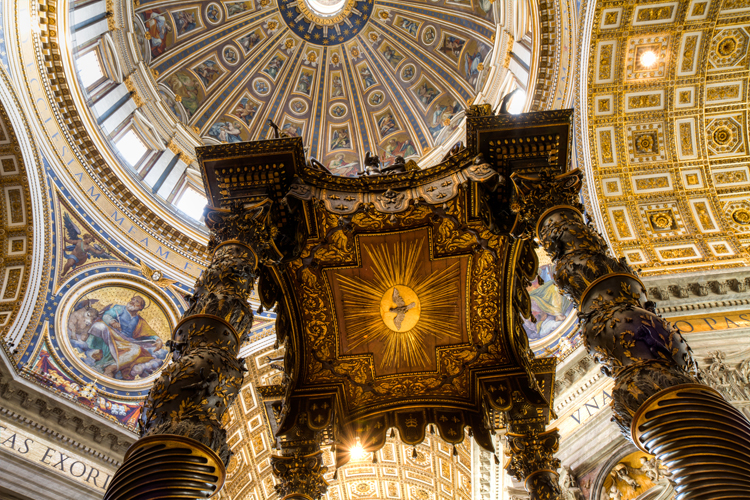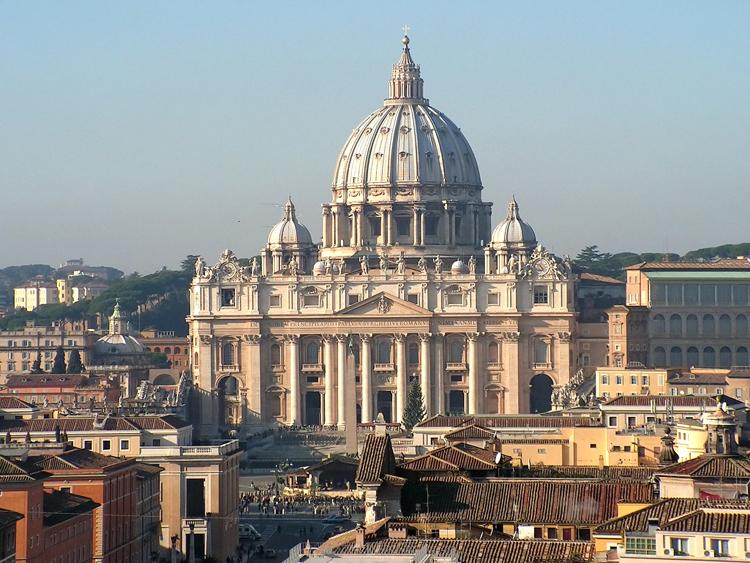On December 8, Pope Francis opened the Holy Door at St. Peter’s Basilica Dome, thus inaugurating the extraordinary Jubilee of Mercy. The door at St. Peter’s was the first ‘porta santa’ to be opened for the Holy Year because this papal basilica is considered the center of Christianity. But the Basilica you see today is very different from how it looked 2,000 years ago, when a church was built over the tomb of Saint Peter, one of the 12 apostles and the first pope according to the Catholic Church.
Old St. Peter’s Basilica
According to Christian tradition, Peter was crucified in Rome at the site of the Clementine Chapel, located in the underground necropolis below St. Peter’s Basilica. You may not know it, but the basilica’s pavement hides two underground levels: the Sacred Vatican Grottoes, with the tombs of popes and the Confession, built where the tomb of the apostle was; and the necropolis, discovered only in the 1940s, dating to the 1st century. Peter was buried not far from where he was crucified; his tomb became a place of worship and, in the 4th century, emperor Constantine ordered the construction of a basilica over the small shrine believed to mark its burial place, the “old St. Peter’s Basilica”. Consisting of a wide nave and two aisles on each side and an apsidal end with the addition of a transept, it was more than 100 meters long, and the entrance was preceded by a large colonnaded atrium.
Construction of the new St. Peter’s

The basilica we see today was built from this one starting in 1506, with the project commissioned to Donato Bramante. By the end of the 15th century, the old basilica was in bad repair. In 1505, Pope Julius II decided to demolish the ancient basilica and replace it with a monumental structure which would house his enormous tomb, to be designed and adorned with sculptures by Michelangelo (he was the pope who also commissioned Michelangelo’s decoration of the ceiling of the Sistine Chapel).
Bramante’s plan was in the form of an enormous Greek Cross with a dome inspired by that of the huge circular Roman temple, the Pantheon. Bramante was later replaced with Giuliano da Sangallo, Fra Giocondo and Raphael. In 1547, during the reign of Pope Paul III, Michelangelo, then in his seventies, was forced by Pope Paul III to take the reins of the works, succeeding to Sangallo the Younger as "Capomaestro", the superintendent of the building program. Michelangelo is responsible for a large part of the building design that we see today. The Latin cross plan is due to Carlo Maderno, who added three chapels to the previous Greek cross plan at the beginning of the 17th century.
The Treasures of St. Peter’s Basilica

Façade
The façade designed by Carlo Maderno between 1607 and 1614 is almost 115 meters wide and 46 meters high and is built of travertine stone, with a giant order of Corinthian columns and a central pediment rising in front of a tall attic surmounted by thirteen statues: Christ flanked by eleven of the Apostles (except Peter, whose statue is left of the stairs) and John the Baptist.
Dome
The dome of St. Peter's rises to a total height of 137 meters from the floor of the basilica to the top of the external cross. It is the tallest dome in the world. It was designed by Michelangelo, who directed its construction until his death in 1564; after that, Giacomo della Porta and Domenico Fontana took over.
Portico
This is where you’ll find the doors of the basilica; the one to the far right is the Holy Door, open only in the Jubilee years.
Staircase
Developed on three levels, it is the work of Bernini. It is preceded on the sides by the 19th century statues of St. Peter and St. Paul.
Square
The Baroque inspiration of Bernini, this grand ellipse is 240 meters wide.
Basilica
When you enter the basilica, it is easy to feel lost. Because it is and feels so immense: it covers a surface of 20,139 square meters and measures 196 meters long, 137 meters wide, 117 meters high.

Baldacchino(Canopy)
The masterpiece by Gian Lorenzo Bernini, it is a pavilion-like structure 30 meters tall, claimed to be the largest piece of bronze in the world. It stands beneath the dome and above the altar and was inaugurated in 1633.
Papal throne
A venerable relic traditionally reputed to be the one used by St. Peter in his teachings as the vicar of Christ.
Pietà
The world-famous sculpture by Michelangelo, made in Carrara marble when he was just 24, was made for the funeral monument of a French cardinal. It was moved to its current location, the first chapel on the right as you enter the basilica, in the 18th century. It is the only piece Michelangelo ever signed.
Statue of St. Peter
The ancient bronze statue of the saint dates back to between the 5th and 8th centuries.

For all its incredible history and art, St. Peter's Basilica can rightly be considered one of Italy's treasures.













